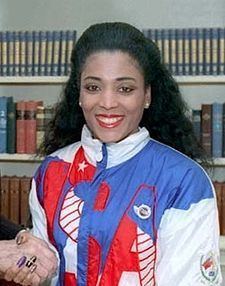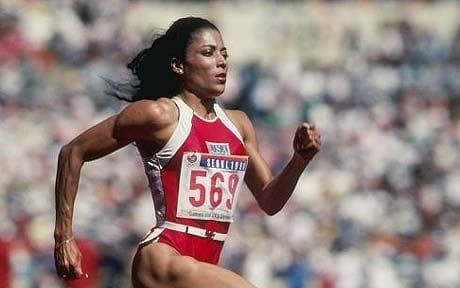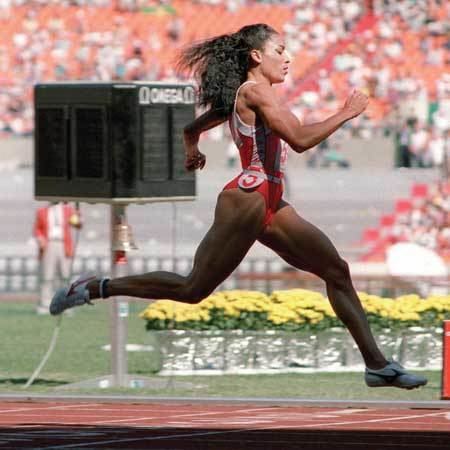Nationality American Name Florence Joyner Children Mary Ruth Joyner Event(s) 100 meters, 200 meters | Sport Running Height 1.7 m Weight 57 kg (126 lb) | |
 | ||
Full name Florence Delorez Griffith Joyner Club Tiger World Class Athletic ClubWest Coast Athletic Club Similar People Died September 21, 1998 (aged 38), Mission Viejo, California, United States | ||
1988 olympic 4x100 women best relay ever usa v east germany v ussr
Florence Delorez Griffith Joyner (December 21, 1959 – September 21, 1998), also known as Flo-Jo, was an American track and field athlete. She is considered the fastest woman of all TIME based on the fact that the world records she set in 1988 for both the 100 m and 200 m still stand. During the late 1980s she became a popular figure in international track and field because of her record-setting performances and flashy personal style.
Contents
- 1988 olympic 4x100 women best relay ever usa v east germany v ussr
- Flo Jo feature on Wide World of Sports
- Early life
- Career
- Olympic runner
- Comeback attempt and other activities
- Style
- Allegations of performance enhancing drug use
- Personal life
- Death
- Legacy
- Olympic Games and trials results
- References

Griffith Joyner was born and raised in California. She was athletic from a young age. She attended California State University, Northridge (CSUN) and University of California, Los Angeles (UCLA) where she participated in track and field. Griffith Joyner qualified for the 100 m 1980 Olympics, although she did not actually compete due to the U.S. boycott. She made her Olympic debut four years later winning a silver medal. At the 1988 U.S. Olympic trials, Griffith set a new world record in the 100 m. She went on to win three gold medals at the 1988 Olympics. Shortly after the 1988 games, she abruptly retired.

After her retirement from athletics, Griffith Joyner remained a pop culture figure through endorsement deals, acting, and designing. She died in her sleep as the result of an epileptic seizure in 1998 at the age of 38.

Flo-Jo feature on Wide World of Sports
Early life

Griffith was born in Los Angeles, California, one of eleven children born to Robert and Florence Griffith. The family lived in Littlerock, California before Florence Griffith moved with her children to the Jordan Downs public housing complex located in the Watts section of Los Angeles.
When Griffith was in elementary school, she joined the Sugar Ray Robinson Organization, running in track meets on weekends. She won the Jesse Owens National Youth Games two years in a row, at the ages of 14 and 15. Griffith ran track at Jordan High School in Los Angeles. Showing an early interest in fashion, Griffith persuaded the members of the track team to wear tights with their uniforms. As a high school senior in 1978, she finished sixth at the CIF California State Meet behind future teammates Alice Brown and Pam Marshall. Nevertheless, by the time Griffith graduated from Jordan High School in 1978, she set high school records in sprinting and long jump.
Career
Griffith attended the California State University at Northridge, and was on the track team coached by Bob Kersee. This team, which included Brown and Jeanette Bolden, won the national championship during Griffith's first year of college. However, Griffith had to drop out to support her family, taking a job as a bank teller. Kersee found financial aid for Griffith and she returned to college in 1980, this time at University of California at Los Angeles (UCLA) where Kersee was working as a coach.
Brown, Bolden, and Griffith qualified for the 100-meter final at the trials for the 1980 Summer Olympics (with Brown winning and Griffith finishing last in the final). Griffith also ran the 200 meters, narrowly finishing fourth, a foot out of a qualifying position. However, the U.S. Government had already decided to boycott those Olympic Games mooting those results. In 1983, Griffith graduated from UCLA with her bachelor's degree in psychology.
Olympic runner
Griffith finished fourth in the 200-meter sprint at the first World Championship in Athletics in 1983. The following year, Griffith qualified for the Olympics in the 200-meter distance with the second fastest time at the United States Olympic Trials, held in Los Angeles. Evelyn Ashford, another UCLA alumnus and early favorite to medal, dropped out of the 200-meter due to injury. Griffith went on to win a silver medal in the 1984 Summer Olympics.
After the 1984 Olympic Games, she spent less time running. Griffith continued to run part time, winning the 100-meter IAAF Grand Prix Final with the time of 11.00 seconds. She did not compete at the 1985 U.S. National Championship. That same year, Griffith returned to working at a bank and styled hair and nails in her spare time. She married Al Joyner, the Olympic triple jump champion of 1984, in 1987.
She returned to athletics in April 1987, having gained weight. Four months later at the 1987 World Championships in Rome, Griffith Joyner finished second in the 200 meter sprint. Her success during the 1987 season resulted in being ranked second in Track and Field News' 1987 world rankings. The 200-meter remained a stronger event for Griffith Joyner than the 100-meter, where she was ranked seventh in the United States.
Before the 1988 U.S. Olympic Trials, Griffith Joyner continued to work with her coach Kersee two days a week, but with her new husband coaching her three days a week. She qualified for the U.S. Olympic Trials at 100-meters based on the 10.96 personal record set in Cologne in 1987. She set a new personal record in the 100 meters in San Diego on June 25, 1988, still shy of then American record holder Evelyn Ashford's three best times. A week before the trials she ran a tune-up race in 10.99 in Santa Monica.
In the first race of the quarterfinals of the U.S. Olympic Trials, she stunned her colleagues when she sprinted 100 meters in 10.49 seconds, a new world record. Since 1997 the International Athletics Annual of the Association of Track and Field Statisticians has listed this performance as "probably strongly wind assisted, but recognized as a world record". Over the two day trials, Griffith Joyner recorded the three fastest times for a woman at 100 meters: 10.49 in the quarter-final, 10.70 in the semi-final, and 10.61 in the finals. At the same Olympic trials Griffith Joyner also set an American record at the 200-meter distance with a time of 21.77 seconds.
Following the Olympic trials, in late July 1988, Griffith Joyner left coach Kersee saying she wanted a coach able to provide more personal attention. Another contributing factor was Griffith Joyner's unhappiness with the lack of sponsorship and endorsement opportunities. In addition to serving as coach, Kersee was Griffith Joyner's manager, as he required all the athletes he coached to use his management services too. Griffith Joyner's decision to sign with personal manager Gordon Baskin therefore necessitated the coaching change. Griffith Joyner left UCLA for UC Irvine with her husband serving as full-time coach.
By now known to the world as "Flo-Jo", Griffith Joyner was the big favorite for the titles in the sprint events at the 1988 Summer Olympics. In the 100-meter final, she ran a 10.54, beating her nearest rival, Evelyn Ashford, by 0.30 seconds. In the 200 meter semifinal, she set the world record of 21.56 seconds and then broke this record, winning the final by 0.22 seconds with a time of 21.34 seconds. At the same Olympics, Griffith Joyner also ran with the 4 × 100 m relay and the 4 × 400 m relay teams. Her team won the 4 × 100 m relay and finished second in the 4 × 400 m relay. This was Griffith Joyner's first internationally rated 4 × 400 m relay. Griffith Joyner left the games having won four Olympic medals, three gold and one silver. At the time, Griffith's medal haul was the second most for female track and field athlete in history, behind only Fanny Blankers-Koen who won four gold medals in 1948.
In February 1989, Griffith Joyner announced her retirement from racing. The retirement followed Canadian sprinter Ben Johnson's scandal over doping. Griffith Joyner cited her new business opportunities outside of sprinting. The month after announcing her retirement, Griffith Joyner was selected as the winner of the James E. Sullivan Award of 1988 as the top amateur athlete in the United States.
Comeback attempt and other activities
Griffith Joyner's success at the 1988 Olympics led to new opportunities. In the weeks following the Olympics, Griffith Joyner earned millions of dollars from endorsement deals, primarily in Japan. Griffith Joyner also signed a deal with toy maker LJN Toys for a Barbie-like doll in her likeness.
Among the things she did away from the track was to design the basketball uniforms for the Indiana Pacers NBA team in 1989. She served as co-chair of President's Council on Physical Fitness. Griffith Joyner appeared in the soap opera Santa Barbara in 1992, as "Terry Holloway", a photographer similar to Annie Leibovitz.
In 1996, Griffith Joyner appeared on Charlie Rose and announced her comeback to competitive athletics, concentrating on the 400-meter run. Her reason was that she had already set world marks in both the 100 m and 200 m events, with the 400 m world record being her goal. Griffith Joyner trained steadily leading up to the U.S. Olympic trials in June. However, tendinitis in her right leg ended her hopes of becoming a triple-world-record holder. Al Joyner also attempted a comeback, but he was unable to compete due to an injured quadriceps muscle.
Style
Beyond her running prowess, Griffith Joyner was known for her bold fashion choices. Griffith Joyner appeared at the World Championships in 1987 in Rome wearing a hooded speed skating body suit. In April 1988 she started wearing a running suit with the right leg of the suit extending to the ankle and the left leg of the suit cut off, a style she called the "one-legger". The running suits also had bold colors such as lime green or purple with white bikini bottoms and embellished with lightning bolts.
Her nails also garnered attention for their length and designs. Her nails were four inches long with tiger stripes at the 1988 Olympic trials before switching to fuchsia. For the Olympic games themselves, Griffith Joyner had six inch nails painted red, white, blue, and gold.
Although many sprinters avoided accessories which might slow them down, Griffith Joyner kept her hair long and wore jewelry while competing. She designed many of her outfits herself and preferred looks which were not conventional.
Allegations of performance-enhancing drug use
Other athletes, including Joaquim Cruz and Ben Johnson, expressed disbelief over Griffith Joyner's dramatic improvement over a short period of time. Before the 1988 track and field season, Griffith Joyner's best time in the 100-meter sprint was 10.96 seconds. In 1988, she improved that by 0.47 seconds (or 0.35 sec for the non-wind-aided time). Similarly, her best before 1988 at 200-meters was 21.96 seconds. In 1988, she improved that by 0.62 seconds to 21.34 seconds, another time that has not been approached. Griffith Joyner attributed the change in her physique to new health programs. Al Joyner replaced Bob Kersee as her coach, and he changed her training program to include more lower body strength training exercises such as squats and lunges.
Darrell Robinson, a former teammate of Griffith Joyner, claimed that he sold her 10 c.c. of HGH for $2,000 in 1988. He said Joyner told him: "if you want to make $1 million, you've got to invest some thousands." Robinson also claimed to receive steroids from coach Bob Kersee, and said he saw Carl Lewis inject himself with drugs he believed to be testosterone. Robinson never provided any evidence for his allegations and was shunned by the athletics community, leading to the premature end of his career.
Griffith Joyner retired from competitive track and field after her Olympic triumph in 1988. She was repeatedly tested during competition, and she passed all of these drug tests. Griffith Joyner made public her decision to retire from Olympic competition one week after it was announced that random out-of-competition drug testing would be instituted during the 1989 season.
After her death in 1998, Prince Alexandre de Merode, the Chairman of the International Olympic Committee's medical commission, claimed that Joyner was singled out for extra, rigorous drug testing during the 1988 Olympic Games because of rumors of steroid use. De Merode told The New York Times that Manfred Donike, who was at that time considered to be the foremost expert on drugs and sports, failed to discover any banned substances during that testing. De Merode later said:
"We performed all possible and imaginable analyses on her. We never found anything. There should not be the slightest suspicion."Personal life
Griffith's nickname among family was "Dee Dee". She was briefly engaged to hurdler Greg Foster. In 1987, Griffith married 1984 Olympic triple jump champion Al Joyner, whom Griffith had first met at the 1980 Olympic Trials. Through her marriage to Joyner she was sister-in-law to track and field athlete Jackie Joyner-Kersee. Griffith Joyner and Joyner had one daughter together, born November 15, 1990.
Death
On September 21, 1998, Griffith Joyner died in her sleep at home in the Canyon Crest neighborhood of Mission Viejo, California, at the age of 38. The unexpected death was investigated by the sheriff-Coroner's office, which announced on September 22 that the cause of death was suffocation during a severe epileptic seizure. She was also found to have had a cavernous hemangioma, a congenital vascular brain abnormality that made Joyner subject to seizures. According to a family attorney, she had suffered a tonic–clonic seizure in 1990, and had also been treated for seizures in 1993 and 1994.
According to the Orange County Sheriff-Coroner's office, the only drugs in her system when she died were small amounts of two common over-the-counter drugs, acetominophen (Tylenol) and Benadryl.
Legacy
USA Track & Field inducted her into its Hall of Fame in 1995. In 2000, the 102nd Street School in Los Angeles was renamed Florence Griffith Joyner Elementary School. Griffith Joyner had attended the school as a child. The city of Mission Viejo dedicated a park at the entrance to her neighborhood in her honor.
Griffith Joyner was also an artist and painter. Her work has been on display as part the Art of The Olympians (AOTO). She is one of two posthumous members of AOTO, the other being the founder and Olympian, Al Oerter.
